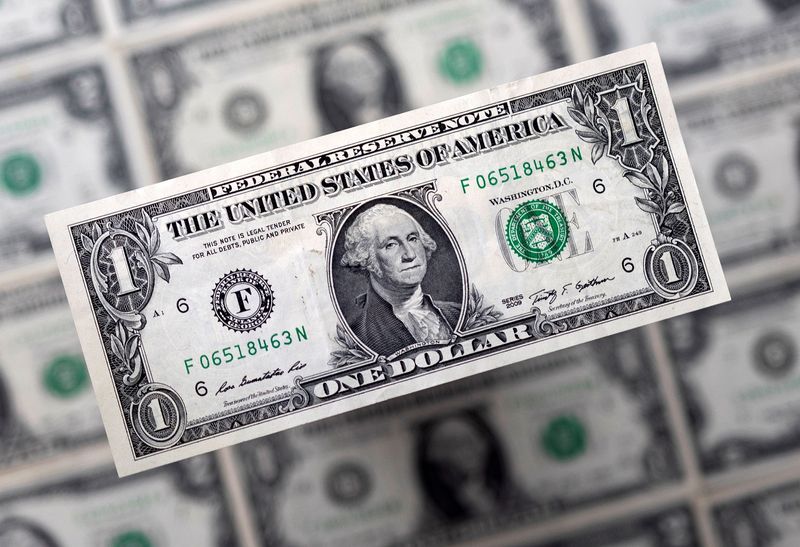Forex
Dollar decline slows as investors wait on Fed


© Reuters. FILE PHOTO: U.S. dollar banknotes are displayed in this illustration taken, February 14, 2022. REUTERS/Dado Ruvic/Illustration/File Photo
By Karen Brettell
NEW YORK (Reuters) – The dollar dipped against a basket of currencies on Monday after last week suffering its largest weekly decline this year as Treasury yields tumbled, but held above more than one-year lows reached on Friday with no major catalysts to drive market direction.
This week is likely to see the dollar consolidate as investors wait on the Federal Reserve’s meeting next week, when the U.S. central bank is expected to hike rates by an additional 25 basis points.
The pace of last week’s dollar decline “seemed unusually large,” said Marc Chandler, chief market strategist at Bannockburn Global Forex in New York, noting that the market should steady and see a firmer dollar this week.
This week’s main U.S. economic focus will be the retail sales report for June on Tuesday, though the data is unlikely to sway the path of monetary policy.
Fed funds futures traders are pricing in an additional 32 basis points of tightening with the benchmark rate expected to peak at 5.40% in November. That implies that the market sees a low chance of further interest rate increases after the Fed’s July 25-26 meeting.
U.S. Treasury yields fell sharply last week as slowing consumer and producer price inflation in June increased expectations that prices pressures will continue to moderate, and in turn lead to more dovish monetary policy.
“Last week’s U.S. disinflation shock altered the FX landscape, but a few days without key data releases will tell us whether that impulse can keep the dollar on the back foot as the FOMC risk event draws nearer,” Francesco Pesole, FX strategist at ING, said.
“Euro/dollar appears a bit overstretched in the short term and could face a correction this week,” he added.
The was last down 0.12% at 99.832, after falling to 99.574 on Friday, the lowest since April 2022.
The euro gained 0.14% on the day to $1.1242, after earlier reaching $1.12445, the highest since February 2022.
The German Bundesbank said on Monday that the euro zone’s largest economy may shrink this year by more than the 0.3% decline expected only a few weeks ago, despite a small bounce in the second quarter.
Industry-heavy Germany is bearing the brunt of a drop in global demand for goods – the result of higher borrowing costs dampening investment and people spending more on leisure, travel and other services in the aftermath of the pandemic.
Germany’s economic output may shrink slightly this year due to the energy price shock and tightening financial conditions, the International Monetary Fund (IMF) said on Monday.
The European Central Bank is also expected to raise interest rates by 25 basis points next week.
The dollar dipped 0.07% against the Japanese yen to 138.65, after dropping to 137.245 on Friday, the lowest since May 17.
The British pound fell 0.06% to $1.3082, after hitting $1.31440 on Thursday, the highest since April 2022.
========================================================
Currency bid prices at 3:00PM (1900 GMT)
Description RIC Last U.S. Close Pct Change YTD Pct High Bid Low Bid
Previous Change
Session
Dollar index 99.8320 99.9600 -0.12% -3.535% +100.1800 +99.7510
Euro/Dollar $1.1242 $1.1227 +0.14% +4.92% +$1.1249 +$1.1205
Dollar/Yen 138.6500 138.7500 -0.07% +5.75% +139.4000 +137.9900
Euro/Yen 155.87 155.83 +0.03% +11.10% +156.3400 +155.1100
Dollar/Swiss 0.8599 0.8621 -0.25% -7.00% +0.8630 +0.8580
Sterling/Dollar $1.3082 $1.3090 -0.06% +8.17% +$1.3109 +$1.3051
Dollar/Canadian 1.3183 1.3217 -0.25% -2.69% +1.3232 +1.3163
Aussie/Dollar $0.6823 $0.6839 -0.22% +0.10% +$0.6845 +$0.6788
Euro/Swiss 0.9666 0.9678 -0.12% -2.31% +0.9683 +0.9644
Euro/Sterling 0.8592 0.8574 +0.21% -2.85% +0.8598 +0.8572
NZ $0.6335 $0.6369 -0.53% -0.23% +$0.6368 +$0.6309
Dollar/Dollar
Dollar/Norway 10.0250 10.0570 -0.33% +2.14% +10.0890 +10.0000
Euro/Norway 11.2710 11.2754 -0.04% +7.41% +11.3165 +11.2354
Dollar/Sweden 10.2326 10.2300 -0.03% -1.68% +10.2875 +10.1756
Euro/Sweden 11.4950 11.4983 -0.03% +3.10% +11.5385 +11.4412

 Forex3 years ago
Forex3 years agoForex Today: the dollar is gaining strength amid gloomy sentiment at the start of the Fed’s week

 Forex3 years ago
Forex3 years agoUnbiased review of Pocket Option broker

 Forex3 years ago
Forex3 years agoDollar to pound sterling exchange rate today: Pound plummeted to its lowest since 1985

 Forex3 years ago
Forex3 years agoHow is the Australian dollar doing today?

 Cryptocurrency3 years ago
Cryptocurrency3 years agoWhat happened in the crypto market – current events today

 World3 years ago
World3 years agoWhy are modern video games an art form?

 Commodities3 years ago
Commodities3 years agoCopper continues to fall in price on expectations of lower demand in China

 Economy3 years ago
Economy3 years agoCrude oil tankers double in price due to EU anti-Russian sanctions





















